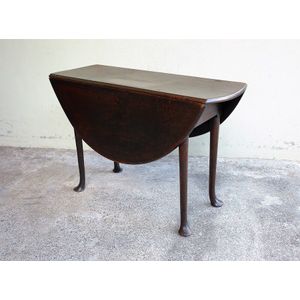19th Century Fruitwood Drop Side Table
An antique country style fruitwood drop side table, 19th century, in mellow light honey tones, the circular drop side table with pull out supports, raised upon knopped and turned slender legs, with peg joins and having a good patina. Height 72 cm. Diameter 127 cm
You must be a subscriber, and be logged in to view price and dealer details.
Subscribe Now to view actual auction price for this item
When you subscribe, you have the option of setting the currency in which to display prices to $Au, $US, $NZ or Stg.
This item has been sold, and the description, image and price are for reference purposes only.
- Fruitwood - A catch-all term used to describe the wood of any of several fruit-bearing trees, such as the apple, cherry, or pear, used especially in cabinetmaking.
With a blond colour when finished, fruitwood was used in Europe, especially France, in the 18th and 19th centuries for larger items of furniture such as tables, chairs, cabinets and bookcases but in England its use was generally restricted to decorative elements such as inlays. - Patination / Patina - In broad terms, patination refers to the exterior surface appearance of the timber, the effect of fading caused by exposure to sunlight and air over the course of a century or more, changing the piece to a soft, mellow colour.
As patina is very difficult to replicate, it is one of the most important guides to determining the age of furniture.
Patina is also the term applied to the bloom or film found on old bronzes due to oxidisation. - Turning - Any part of a piece of furniture that has been turned and shaped with chisels on a lathe. Turned sections include legs, columns, feet, finials, pedestals, stretchers, spindles etc. There have been many varieties and fashions over the centuries: baluster, melon, barley-sugar, bobbin, cotton-reel, rope-twist, and so on. Split turning implies a turned section that has been cut in half lengthwise and applied to a cabinet front as a false decorative support.
This item has been included into following indexes:
Visually similar items

A George III red walnut wake table, Irish, 18th century. 72 cm high, 182 cm wide and 52 cm deep closed. Provenance: Private Collection, Melbourne
Sold by
in
for
You can display prices in $Au, $US, $NZ or Stg.

A small 19th century oak Sutherland table
Sold by
in
for
You can display prices in $Au, $US, $NZ or Stg.

A cherry wood supper table, French 19th century., 70 cm high, 130 cm diameter
Sold by
in
for
You can display prices in $Au, $US, $NZ or Stg.

A George III mahogany drop-side gate-leg table, plain cabriole legs. 108 cm x 110 cm x 70 cm
Sold by
in
for
You can display prices in $Au, $US, $NZ or Stg.
